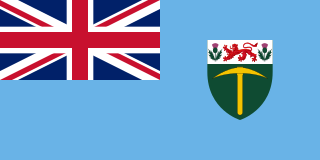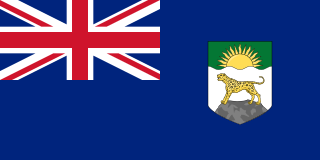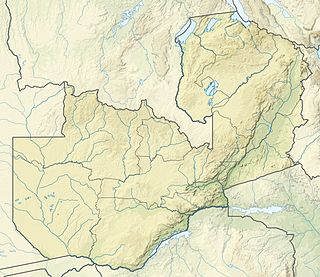Composition of the Federal Assembly
Voters elected 35 members of a unicameral Federal Assembly: 14 from Southern Rhodesia constituencies, 8 from Northern Rhodesia constituencies, and four from Nyasaland. In addition, there were three members from each territory representing African interests: one of these was a European and two were African. In Southern Rhodesia only, these positions were elected; in the other territories, the Governor appointed the European member, while an electoral college chose the African members.

The Colony of Southern Rhodesia was a self-governing British Crown colony in southern Africa. It was the predecessor state of what is now Zimbabwe.

Northern Rhodesia was a protectorate in south central Africa, formed in 1911 by amalgamating the two earlier protectorates of Barotziland-North-Western Rhodesia and North-Eastern Rhodesia. It was initially administered, as were the two earlier protectorates, by the British South Africa Company (BSAC), a chartered company on behalf of the British Government. From 1924 it was administered by the British Government as a protectorate under similar conditions to other British-administered protectorates, and the special provisions required when it was administered by BSAC were terminated.

Nyasaland was a British Protectorate located in Africa that was established in 1907 when the former British Central Africa Protectorate changed its name. Between 1953 and 1963, Nyasaland was part of the Federation of Rhodesia and Nyasaland. After the Federation was dissolved, Nyasaland became independent from Britain on 6 July 1964 and was renamed Malawi.
Election campaign
The advent of the Federation caused a profound shift in the structure of politics in the Rhodesias. Godfrey Huggins formed the Federal Party to fight the election, merging his own United Party with the opposition Rhodesia Party and incorporating supporters in Northern Rhodesia and Nyasaland. Several members of other opposition parties in Southern Rhodesia who supported federation also decided to join the Federal Party. Among them were William Eastwood, from the Rhodesia Labour Party, whose departure was prompted by the initial decision of his Party to fight the elections: Eastwood felt that this would divide supporters of federation. Another opposition member going over to the Federal Party was Ian Smith, who had been elected as a Liberal candidate in the 1948 general election.

The Rhodesia Labour Party was a political party which existed in Southern Rhodesia from 1923 until the 1950s. Originally formed on the model of the British Labour Party from trade unions and being especially dominated by railway workers, it formed the main opposition party from 1934 to 1946. The party suffered a catastrophic split during the Second World War and lost all its seats, and a further split over the attitude to the Federation of Rhodesia and Nyasaland ended its involvement in Rhodesian politics.

Ian Douglas Smith was a politician, farmer, and fighter pilot who served as Prime Minister of Rhodesia from 1964 to 1979. As the country's first premier that was not born abroad, he led the predominantly white government that unilaterally declared independence from the United Kingdom in 1965, following prolonged dispute over the terms. He remained Prime Minister for almost all of the fourteen years of international isolation that followed, and oversaw Rhodesia's security forces during most of the Bush War, which pitted the unrecognised administration against communist-backed black nationalist guerrilla groups. Smith, who has been described as personifying white Rhodesia, remains a highly controversial figure—supporters venerate him as a man of integrity and vision "who understood the uncomfortable truths of Africa", while critics describe an unrepentant racist whose policies and actions caused the deaths of thousands and contributed to Zimbabwe's later crises.

The Southern Rhodesian Liberal Party was a political party in Southern Rhodesia, founded in 1939 by Jacob Smit (1881–1959), the former United Party (UP) Minister of Finance. It is thought that Smit split from the UP largely because Prime Minister Sir Godfrey Martin Huggins had failed to include him in the exclusive Second World War Defence Committee.
Opponents of federation formed the Confederate Party, which advocated a system in the Rhodesias akin to apartheid in South Africa. This issue was also raised by Huggins who campaigned vigorously against it. Huggins believed the policy was unpopular and impractical. A group called the Progressive Party was formed to offer voters a party of the centre-left, but swiftly dissolved when it found organising a difficulty and realised it would not be able to nominate more than about two candidates. There were a few independent candidates, most notably two in Northern Rhodesia. Dr Alexander Scott in Lusaka and Norman Lacey in the copperbelt constituency of Nkana-Chingola both advocated a liberal racial policy similar to that which the Progressive Party had been intending to offer.
The Confederate Party was a political party in the Federation of Rhodesia and Nyasaland.

Apartheid was a system of institutionalised racial segregation that existed in South Africa from 1948 until the early 1990s. Apartheid was characterised by an authoritarian political culture based on baasskap, which encouraged state repression of Black African, Coloured, and Asian South Africans for the benefit of the nation's minority white population. The economic legacy and social effects of apartheid continue to the present day.

Lusaka is the capital and largest city of Zambia. One of the fastest developing cities in southern Africa, Lusaka is in the southern part of the central plateau at an elevation of about 1,279 metres (4,196 ft). As of 2010, the city's population was about 1.7 million, while the urban population is 2.4 million. Lusaka is the centre of both commerce and government in Zambia and connects to the country's four main highways heading north, south, east and west. English is the official language of the city, and Nyanja and Bemba are also common.
One unusual court case arose after nominations. Gaston Thornicroft, a mixed-race man who was described as "living like a European", was refused nomination for the Southern Rhodesia constituency for Europeans to represent African interests on the grounds that he was not a European. He challenged the decision in court but was unsuccessful.
Gaston Thomas Thornicroft was a leader of the Coloured (mixed-race) community in Southern Rhodesia from the 1930s to the 1960s. His father was Harry Scott Thornicroft, a British colonial administrator, who married a native African woman. Gaston was president of two groups advocating rights for Coloureds: the Coloured Community Service League from 1933, and the Rhodesia National Association from 1952 till it was eclipsed in the early 1960s by more radical black unity groups. He led talks to unite competing Coloured representative associations. Initially he emphasised the Coloured community's separateness from and superiority to black Africans; but later was sympathetic to the non-white unity movement, without ever formally joining it. He was a businessman, running 18 stores by 1945. In the 1953 general election in the Federation of Rhodesia and Nyasaland, one seat was reserved for a European representing African interests; Thornicroft applied to stand but was refused as not being European. He represented "Coloured & Eurafrican Communities" at the 1961 Southern Rhodesia constitutional talks. He ran unsuccessfully in the 1962 and 1970 general elections in (Southern) Rhodesia.
Changes during the Assembly
Southern Rhodesia by-election
Rev. Percy Ibbotson, the specially elected European member representing African interests from Southern Rhodesia, died on 3 April 1955. When nominations closed on 27 May 1955, Harry Ellinder Davies was the only candidate to replace him, and was therefore declared elected unopposed.
Kafue by-election
Guy Van Eeden, who became increasingly opposed to Federal Party policies, was expelled from the party in July 1955 and responded by resigning on 8 July 1955 to seek re-election in his constituency of Kafue (Northern Rhodesia). The by-election was held on 6 October 1955.
Sebakwe by-election
J.R. Dendy Young, the Confederate Party member for Sebakwe (Southern Rhodesia), was appointed as a Judge. He resigned on 26 January 1956, and the by-election to succeed him was held on 5 April 1956. By this time, the Confederate Party had been dissolved and replaced by the Dominion Party.
Constituency
Electorate and turnout | Candidate | Party | Votes | % |
|---|
| SEBAKWE | Robert Williamson | DP | 805 | 36.7 |
| Dr Morris Isaac Hirsch | Federal Party | 786 | 35.8 |
| Johannes Mathys de Kock | Com P | 603 | 27.5 |
Mrewa by-election
Neville Barrett, the Federal Party member for Mrewa (Southern Rhodesia) died on 15 April 1957. The by-election to replace him was held on 6 June 1957.
Mashonaland by-election
Jasper Savanhu, the specially elected African member for Mashonaland (Southern Rhodesia), had problems with the proposed new constitution in terms of its provisions for voters' qualifications. Although his responsibility was to represent the views of Africans, his electorate were predominantly Europeans. He therefore decided to vote for the proposals, but immediately to resign (1 August 1957) and seek re-election. When nominations closed on 27 September 1957, he was the only candidate nominated, and was therefore declared elected unopposed.
Seat vacant at dissolution
Paul Brereton (Federal Party), one of the ordinary members for Nyasaland, died on 21 July 1958. The seat was left vacant due to the imminent federal election.
This page is based on this
Wikipedia article Text is available under the
CC BY-SA 4.0 license; additional terms may apply.
Images, videos and audio are available under their respective licenses.

Sir Roland "Roy" Welensky, KCMG was a Northern Rhodesian politician and the second and last prime minister of the Federation of Rhodesia and Nyasaland.

Elections in Zambia take place within the framework of a multi-party democracy and a presidential system. The President and National Assembly are simultaneously elected for five-year terms.

Elections in Southern Rhodesia were used from 1899 to 1923 to elect part of the Legislative Council and from 1924 to elect the whole of the Legislative Assembly which governed the colony. Since the granting of self-government in 1923, Southern Rhodesia used the Westminster parliamentary system as its basis of government. The Political party that had most of the seats in the Legislative Assembly became the government. The person in charge of this bloc was the Premier, later renamed Prime Minister, who then chose his cabinet from his elected colleagues.
The Rhodesia general election of 30 July 1974 saw the Rhodesian Front of Ian Smith re-elected, once more winning every one of the 50 seats elected by white voters.
The Southern Rhodesia general election of 1962 took place on 14 December 1962. Voters elected 65 members of the Legislative Assembly. The election was notable for bringing to power the Rhodesian Front, initially under Winston Field, which set the colony on the course for its eventual Unilateral Declaration of Independence.
The Southern Rhodesia general election of 15 September 1948 saw the Prime Minister Godfrey Huggins regain the overall majority he had lost at the previous election. Huggins won a landslide, reducing the opposition Liberal Party to a small minority.

General elections were held in Northern Rhodesia on 19 February 1954. The result was a victory for the Federal Party, which won 10 of the 12 elected European seats in the Legislative Council.

General elections were held in Northern Rhodesia on 20 March 1959, although voting did not take place in two constituencies until 9 April. The United Federal Party (UFP) was expected to win the elections, and did so by taking 13 of the 22 elected seats on the Legislative Council.

General elections were held for the first time in Nyasaland on 15 March 1956.

The Bledisloe Commission, also known as the Rhodesia-Nyasaland Royal Commission, was a Royal Commission appointed in 1937–39 to examine the possible closer union of the three British territories in Central Africa, Southern Rhodesia, Northern Rhodesia and Nyasaland. These territories were to some degree economically inter-dependent, and it was suggested that an association would promote their rapid development. Its chairman was Lord Bledisloe.

Godfrey Martin Huggins, 1st Viscount Malvern was a Rhodesian politician and physician. He served as the fourth Prime Minister of Southern Rhodesia from 1933 to 1953 and remained in office as the first Prime Minister of the Federation of Rhodesia and Nyasaland until 1956, becoming the longest serving prime minister in British Commonwealth history.
Federal elections were held in the Federation of Rhodesia and Nyasaland on 12 November 1958. The result was a victory for the ruling United Federal Party, with Roy Welensky remaining Prime Minister.
Federal elections were held in the Federation of Rhodesia and Nyasaland on 27 April 1962. Due to a boycott by all opposition parties, the ruling United Federal Party was the only party to contest the election.

The Nyasaland Association was a political party in Nyasaland.
The Dominion Party was a political party in the Federation of Rhodesia and Nyasaland, led by Winston Field.
Maureen Thelma Watson was a Rhodesian politician.
Michael Hill Blackwood (1917-2005) was a lawyer and politician who spent most of his working life in colonial Nyasaland and in Malawi in the early years of its independence. Although he represented the interests of European settlers before independence and opposed both the transfer of power to the African majority and the break-up of the Federation of Rhodesia and Nyasaland, after Malawi’s independence, he remained in the country as a member of its legislature until his retirement.













